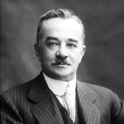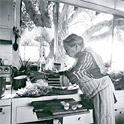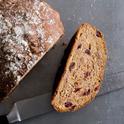Wandering along Ioannina’s main drag, you can’t help but notice all the silver, copper, and bronze wares—everything from water pitchers to elaborate belt buckles—jangling from the shops, bearing witness to the city’s past as a bustling trade center known primarily for its metalsmiths. The old city, contained within the walls that Ali Pa_a, the “Lion of Ioannina,” built when he was overlord here during the late 18th and early 19th centuries, is filled with lean Ottoman-era houses, narrow, winding cobbled streets, and the fortress itself, its slim minarets lending an anachronistic Eastern air to the old part of town.
We bought a ticket for the small ferry that chugs back and forth every half hour or so to To Nisi, the tiny island that looms from the fog that seems always to be hovering over the lake. Disembarking with island denizens (just a few dozen families call it home), excursion-thirsty locals, and other curious tourists, we proceeded to walk the entire island in 20 minutes, then relaxed over a lunch of batter-fried frogs’ legs and sweet water crabs with walnut-garlic sauce—culinary claims to fame available at any of To Nisi’s handful of small tavernas.
Driving east out of the city, we were two hours on hairpin turns before arriving, harried, in Metsovo. It’s easy to see, amid the dense oak and chestnut forests, why this part of the country has long been known for its wood craftsmen. There aren’t many left today, but we were determined nonetheless to seek out the dying art of the barrelmakers whose creations are responsible for the smokiness that gives Greece’s world-renowned feta so much of its cachet.
The Dallas family, like most barrelmakers, produce their wares in a highly mechanized factory. We had to shout to hear each other over the buzz created by the women (there were few men on the floor) cutting planks into strips and separating and slowly training them into barrels, first by fitting them with one set of rings, then by boiling them and hammering again with a second set of rings. Others were smoothing over the rough spots with lathes, while still others sanded, shaved, and shined them.
Epirus’s barrel-made feta is undoubtedly a culinary treasure, but there are several other worthwhile cheeses made in this part of the country. The road to Metsovo is studded with small facilities turning out hard chèvres dotted with peppercorns; smoked, log-shaped cheeses not unlike smoked provolone; myzithra, a whey cheese; and soft, sour, naturally fermented galotyri (which Vassilis makes every summer from the milk of his own herb-munching goats).
We pulled into the parking lot of the Tossitsa-Averoff cheese company, founded in the mid-1970s by one of the village’s noble families. An attempt to revitalize the town in the face of an employment crisis that was seeing its younger generation moving away, the modern facility succeeded in giving local shepherds an outlet for their milk, and, therefore, a reason to stick around.


 Pinterest
Pinterest






